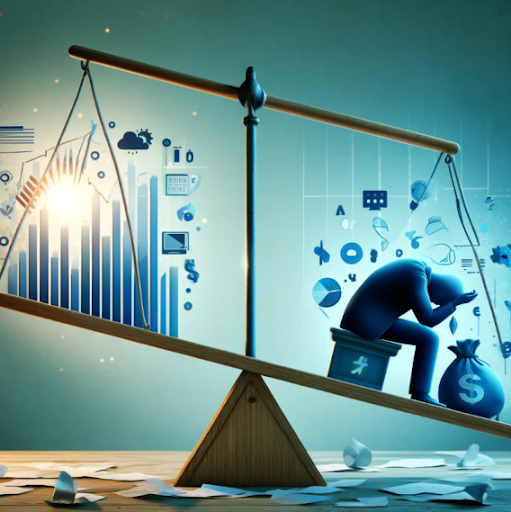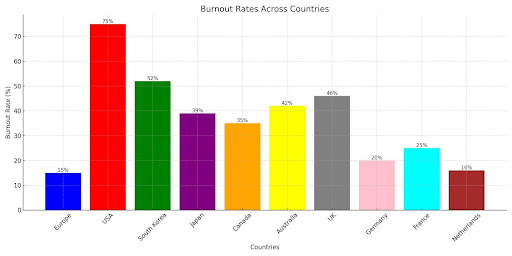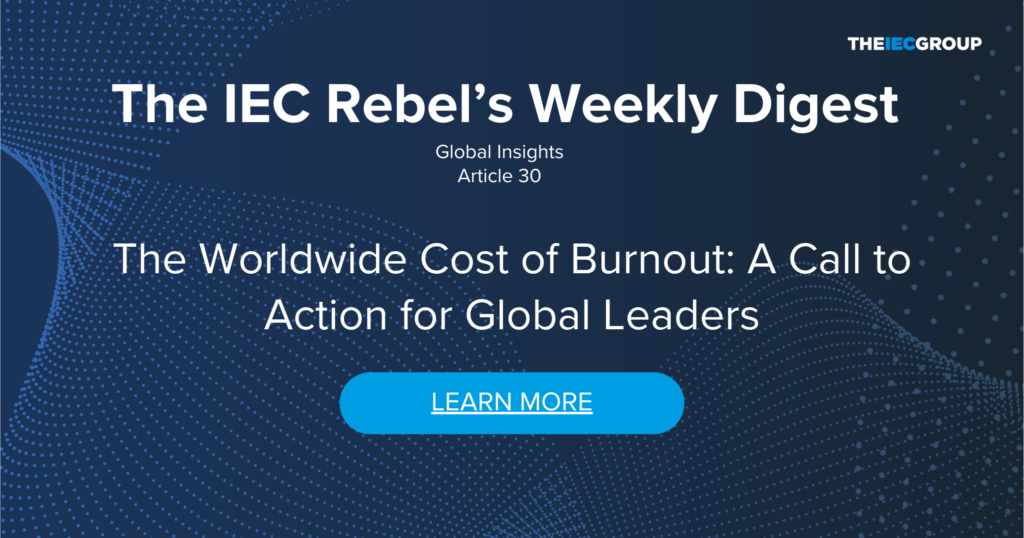From Exhaustion to Innovation: Rethinking America’s $490 Billion Burnout Battle
The USA grapples with a staggering annual loss of $490 billion due to burnout, raising critical questions about corporate responsibility and effectiveness in safeguarding employee well-being. Are companies doing enough to stem this massive drainage of employee performance and health? Current strategies often seem like mere band-aids on a deep-seated wound.
 As we delve into key numbers and facts, it becomes evident that traditional methods of addressing burnout—while well-intentioned—may no longer suffice. When we compare this on a global level, radical differences emerge, highlighting diverse approaches and outcomes in managing employee burnout.
As we delve into key numbers and facts, it becomes evident that traditional methods of addressing burnout—while well-intentioned—may no longer suffice. When we compare this on a global level, radical differences emerge, highlighting diverse approaches and outcomes in managing employee burnout.
Let’s dive into some numbers and analysis, and explore recommendations in the IEC Rebel’s Digest article. The need for a radical overhaul in our approach to workplace health and productivity is clear, but the readiness to implement such changes remains in question. Is the rising burnout rate merely a symptom of today’s fast-paced world and changing generational expectations, or can innovative, bold measures truly turn the tide?
BURNOUT – The Drainage of Performance: Key Statistics and Impacts
Burnout is a significant and growing problem worldwide, impacting individuals, organizations, and economies. Here’s an overview of some key statistics and impacts:
Global Statistics
- Prevalence: Burnout affects a large portion of the global workforce. A 2021 APA survey found that 79% of U.S. employees experienced work-related stress in the preceding month, with over 30% feeling overwhelmed or burned out frequently.
- Increase: The COVID-19 pandemic exacerbated the issue, with a 2021 Gallup survey indicating 76% of U.S. employees experience burnout at least sometimes, up from 61% in 2018.
- Healthcare Sector: The WHO recognizes burnout as an occupational phenomenon in its ICD-11, highlighting its prevalence especially in healthcare.
Impacts on Individuals

- Health: Burnout can lead to anxiety, depression, cardiovascular disease, and impaired immune function.
- Productivity: It impairs cognitive function, leading to decreased productivity and poor job performance.
- Relationships: It strains personal relationships, reducing social engagement.
Impacts on Organizations
- Absenteeism: Burnout-related issues contribute to an estimated 1 million workers calling in sick each day in the U.S.
- Turnover: High burnout rates increase turnover, significantly costing organizations in recruitment and training.
- Quality of Work: It leads to a decrease in work quality, affecting client satisfaction and the bottom line.
Impacts on the Economy
- Healthcare Costs: Burnout contributes significantly to healthcare costs, with workplace stress costing U.S. businesses around $190 billion annually.
- Productivity Loss: U.S. businesses lose about $300 billion annually due to stress-related absenteeism, turnover, and diminished productivity.
Multi-Pronged Approach to Addressing Burnout
To effectively address burnout, actions at multiple levels—individual, organizational, and policy—are necessary:
- Individuals should focus on self-care, work-life balance, and seeking help when needed.
- Employers can offer flexible work arrangements, foster a supportive culture, and ensure manageable workloads.
- Policymakers can enact laws promoting work-life balance, improve access to mental health services, and fund public awareness campaigns.
Development Over Decades
Burnout has evolved significantly over the past 3-4 decades:
- 1980s-1990s: The rise of personal computers and the internet increased efficiency but also created new stressors, including a “24/7” work culture.
- 2000s: The digital revolution and the ability to work from anywhere increased the risk of burnout.
- 2010s: Recognition of mental health issues grew, with the WHO classifying burnout as an occupational phenomenon.
- 2020s: The COVID-19 pandemic brought increased remote work and stress, highlighting the need for improved mental health initiatives.
Subjective Experience and Generational Differences
The experience of burnout varies by individual, influenced by work hours, job satisfaction, and generational attitudes. Younger generations prioritize work-life balance and mental health, potentially making them more sensitive to burnout.
Difference between Industries and Company Cultures
Burnout varies significantly between industries and companies. Healthcare, technology, education, and finance sectors face unique stressors that contribute to high burnout rates. Organizational culture also plays a critical role, with supportive environments mitigating burnout and toxic environments exacerbating it.
Comparisons between Countries or Regions
Burnout rates vary internationally due to differences in work culture, social policies, and economic conditions. For example, many European countries have shorter workweeks and strong labor laws that help mitigate burnout, while in the U.S., a culture of long hours contributes to higher burnout rates.

Disclaimer: The burnout rates presented are based on publicly available data from various sources. We cannot guarantee the consistency of these figures for direct comparison due to potential variations in survey methodologies, timing, and interpretation. Although the data primarily comes from surveys conducted in 2021 and 2022, differences in the questions asked and the interpretation of responses may affect comparability.
Average Work Hours and Productivity
Work hours and productivity also vary significantly across countries. While European countries generally have shorter workweeks, countries like the U.S. and Japan see longer hours. Despite shorter hours, countries like Germany and France maintain high productivity levels.
Role Model
Companies like Google, Salesforce, and Microsoft balance employee health and productivity by fostering supportive cultures and offering comprehensive resources. This balance allows them to serve as role models for other companies, demonstrating that productivity and employee well-being can coexist harmoniously.
DEC’s work culture fostered innovation, collaboration, and passion, contributing to a positive work environment with lower burnout rates. Today’s tech industry, while offering flexibility and wellness initiatives, also faces challenges such as rapid innovation, “hustle culture,” and job volatility, contributing to stress and burnout. The balance between fostering innovation and supporting employee well-being remains a key challenge for modern companies. Lessons from DEC’s culture, including collaboration, passion, and stability, can provide valuable insights for creating healthier work environments today.
Tipping Point
There exists a tipping point in organizations where pushing for increased performance can lead to heightened levels of burnout, ultimately having a detrimental effect on business outcomes. This tipping point occurs when the intensity and pace of work exceed an employee’s capacity to cope with stress, leading to decreased productivity, lower job satisfaction, and increased turnover rates.
EARLY STAGE RECOGNITION
Assessing the burnout potential of a workforce at an early stage is crucial for preventing its negative impacts on both employees and the organization. Here are steps and strategies that companies can use to identify burnout risk factors early:
- Surveys and Questionnaires:
- Burnout Assessment Tools: Use established tools like the Maslow Burnout Inventory (MBI) or the Copenhagen Burnout Inventory (CBI) to measure burnout levels in the workforce. These tools assess emotional exhaustion, depersonalization, and personal accomplishment, providing insights into burnout risk.
- Regular Surveys: Conduct regular anonymous surveys to gauge employee satisfaction, stress levels, workload, and job satisfaction. This helps identify early warning signs of burnout.
- Performance Metrics:
- Productivity: Monitor productivity levels, absenteeism, and turnover rates. Significant drops in productivity or increases in absenteeism and turnover can indicate potential burnout.
- Quality of Work: Track the quality of work output, including error rates and client satisfaction. A decline in quality can be a sign of stress and burnout.
- Open Communication:
- Feedback Channels: Create open communication channels between employees and management, such as regular check-ins, feedback sessions, or suggestion boxes. This allows employees to voice concerns and highlight stressors early.
- One-on-One Meetings: Encourage managers to hold regular one-on-one meetings with their team members to discuss workloads, challenges, and overall well-being. This can help identify potential burnout triggers and offer support.
- Workload Assessment:
- Workload Review: Regularly review workloads and job responsibilities to ensure they are manageable and evenly distributed. High workloads and unreasonable expectations can contribute to burnout.
- Work-Life Balance: Monitor employees’ work-life balance by assessing overtime hours and ensuring flexible work arrangements are available to those who need them.
- Organizational Culture:
- Company Culture Audit: Assess the organization’s culture to ensure it supports employee well-being. Cultures that promote work-life balance, collaboration, and support can reduce burnout risk.
- Mental Health Resources: Ensure that the organization provides mental health resources, such as Employee Assistance Programs (EAPs), counseling, and wellness initiatives, and evaluate their usage and effectiveness.
- Employee Assistance Programs (EAPs):
- Utilization: Monitor the utilization rates of EAPs and other mental health resources. Low utilization may indicate that employees are not aware of these resources or do not feel comfortable using them.
- Support: Ensure EAPs provide comprehensive support for managing stress, including counseling, stress management workshops, and other resources.
Companies can assess the burnout potential of their workforce early by implementing a combination of surveys, performance metrics, open communication, workload assessments, cultural audits, and EAPs. Regularly monitoring and addressing stressors can help prevent burnout and create a healthier work environment. Additionally, fostering a supportive culture and providing mental health resources can further reduce burnout risk and support employee well-being.
Conclusion
Burnout is a multifaceted issue that has evolved due to technological, societal, and economic changes. Addressing it effectively requires a multi-pronged approach that includes individual self-care, supportive organizational cultures, and proactive policy measures. Continued focus on mental health support, work-life balance, and flexible work arrangements is essential for managing and preventing burnout.
Go To’s: To effectively tackle burnout, organizations must prioritize external, objective, and anonymous surveys to gauge the true extent of employee burnout. Engaging independent consultants to analyze these insights ensures unbiased evaluation and actionable recommendations. This approach not only identifies burnout levels accurately but also fosters trust among employees, enhancing the effectiveness of any intervention strategies implemented.
This article is an excerpt from the IEC Executive Direction research paper. If you are not a customer with full access but interested in reading the full article please contact pm@theIECgroup.com for a complimentary copy.
[/ihc-hide-content]



